Bin Huang
Diffusion Transformer Meets Random Masks: An Advanced PET Reconstruction Framework
Mar 11, 2025Abstract:Deep learning has significantly advanced PET image re-construction, achieving remarkable improvements in image quality through direct training on sinogram or image data. Traditional methods often utilize masks for inpainting tasks, but their incorporation into PET reconstruction frameworks introduces transformative potential. In this study, we pro-pose an advanced PET reconstruction framework called Diffusion tRansformer mEets rAndom Masks (DREAM). To the best of our knowledge, this is the first work to integrate mask mechanisms into both the sinogram domain and the latent space, pioneering their role in PET reconstruction and demonstrating their ability to enhance reconstruction fidelity and efficiency. The framework employs a high-dimensional stacking approach, transforming masked data from two to three dimensions to expand the solution space and enable the model to capture richer spatial rela-tionships. Additionally, a mask-driven latent space is de-signed to accelerate the diffusion process by leveraging sinogram-driven and mask-driven compact priors, which reduce computational complexity while preserving essen-tial data characteristics. A hierarchical masking strategy is also introduced, guiding the model from focusing on fi-ne-grained local details in the early stages to capturing broader global patterns over time. This progressive ap-proach ensures a balance between detailed feature preservation and comprehensive context understanding. Experimental results demonstrate that DREAM not only improves the overall quality of reconstructed PET images but also preserves critical clinical details, highlighting its potential to advance PET imaging technology. By inte-grating compact priors and hierarchical masking, DREAM offers a promising and efficient avenue for future research and application in PET imaging. The open-source code is available at: https://github.com/yqx7150/DREAM.
RED: Residual Estimation Diffusion for Low-Dose PET Sinogram Reconstruction
Nov 08, 2024
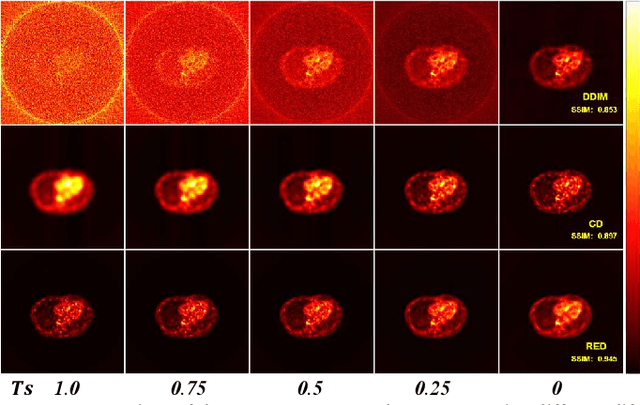
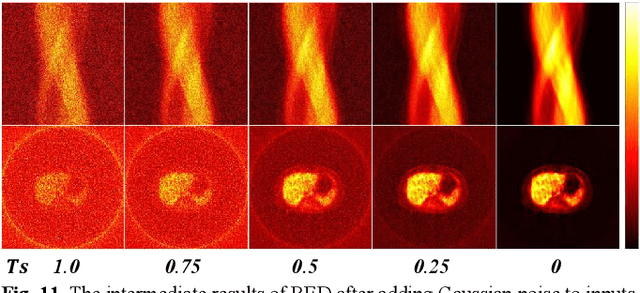
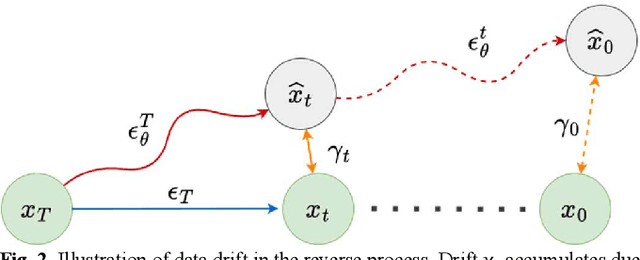
Abstract:Recent advances in diffusion models have demonstrated exceptional performance in generative tasks across vari-ous fields. In positron emission tomography (PET), the reduction in tracer dose leads to information loss in sino-grams. Using diffusion models to reconstruct missing in-formation can improve imaging quality. Traditional diffu-sion models effectively use Gaussian noise for image re-constructions. However, in low-dose PET reconstruction, Gaussian noise can worsen the already sparse data by introducing artifacts and inconsistencies. To address this issue, we propose a diffusion model named residual esti-mation diffusion (RED). From the perspective of diffusion mechanism, RED uses the residual between sinograms to replace Gaussian noise in diffusion process, respectively sets the low-dose and full-dose sinograms as the starting point and endpoint of reconstruction. This mechanism helps preserve the original information in the low-dose sinogram, thereby enhancing reconstruction reliability. From the perspective of data consistency, RED introduces a drift correction strategy to reduce accumulated prediction errors during the reverse process. Calibrating the inter-mediate results of reverse iterations helps maintain the data consistency and enhances the stability of reconstruc-tion process. Experimental results show that RED effec-tively improves the quality of low-dose sinograms as well as the reconstruction results. The code is available at: https://github.com/yqx7150/RED.
Precise Drive with VLM: First Prize Solution for PRCV 2024 Drive LM challenge
Nov 05, 2024



Abstract:This technical report outlines the methodologies we applied for the PRCV Challenge, focusing on cognition and decision-making in driving scenarios. We employed InternVL-2.0, a pioneering open-source multi-modal model, and enhanced it by refining both the model input and training methodologies. For the input data, we strategically concatenated and formatted the multi-view images. It is worth mentioning that we utilized the coordinates of the original images without transformation. In terms of model training, we initially pre-trained the model on publicly available autonomous driving scenario datasets to bolster its alignment capabilities of the challenge tasks, followed by fine-tuning on the DriveLM-nuscenes Dataset. During the fine-tuning phase, we innovatively modified the loss function to enhance the model's precision in predicting coordinate values. These approaches ensure that our model possesses advanced cognitive and decision-making capabilities in driving scenarios. Consequently, our model achieved a score of 0.6064, securing the first prize on the competition's final results.
VERIFIED: A Video Corpus Moment Retrieval Benchmark for Fine-Grained Video Understanding
Oct 11, 2024Abstract:Existing Video Corpus Moment Retrieval (VCMR) is limited to coarse-grained understanding, which hinders precise video moment localization when given fine-grained queries. In this paper, we propose a more challenging fine-grained VCMR benchmark requiring methods to localize the best-matched moment from the corpus with other partially matched candidates. To improve the dataset construction efficiency and guarantee high-quality data annotations, we propose VERIFIED, an automatic \underline{V}id\underline{E}o-text annotation pipeline to generate captions with \underline{R}el\underline{I}able \underline{FI}n\underline{E}-grained statics and \underline{D}ynamics. Specifically, we resort to large language models (LLM) and large multimodal models (LMM) with our proposed Statics and Dynamics Enhanced Captioning modules to generate diverse fine-grained captions for each video. To filter out the inaccurate annotations caused by the LLM hallucination, we propose a Fine-Granularity Aware Noise Evaluator where we fine-tune a video foundation model with disturbed hard-negatives augmented contrastive and matching losses. With VERIFIED, we construct a more challenging fine-grained VCMR benchmark containing Charades-FIG, DiDeMo-FIG, and ActivityNet-FIG which demonstrate a high level of annotation quality. We evaluate several state-of-the-art VCMR models on the proposed dataset, revealing that there is still significant scope for fine-grained video understanding in VCMR. Code and Datasets are in \href{https://github.com/hlchen23/VERIFIED}{https://github.com/hlchen23/VERIFIED}.
Diffusion Transformer Model With Compact Prior for Low-dose PET Reconstruction
Jul 01, 2024Abstract:Positron emission tomography (PET) is an advanced medical imaging technique that plays a crucial role in non-invasive clinical diagnosis. However, while reducing radiation exposure through low-dose PET scans is beneficial for patient safety, it often results in insufficient statistical data. This scarcity of data poses significant challenges for accurately reconstructing high-quality images, which are essential for reliable diagnostic outcomes. In this research, we propose a diffusion transformer model (DTM) guided by joint compact prior (JCP) to enhance the reconstruction quality of low-dose PET imaging. In light of current research findings, we present a pioneering PET reconstruction model that integrates diffusion and transformer models for joint optimization. This model combines the powerful distribution mapping abilities of diffusion models with the capacity of transformers to capture long-range dependencies, offering significant advantages for low-dose PET reconstruction. Additionally, the incorporation of the lesion refining block and penalized weighted least squares (PWLS) enhance the recovery capability of lesion regions and preserves detail information, solving blurring problems in lesion areas and texture details of most deep learning frameworks. Experimental results demonstrate the effectiveness of DTM in enhancing image quality and preserving critical clinical information for low-dose PET scans. Our approach not only reduces radiation exposure risks but also provides a more reliable PET imaging tool for early disease detection and patient management.
M4Fog: A Global Multi-Regional, Multi-Modal, and Multi-Stage Dataset for Marine Fog Detection and Forecasting to Bridge Ocean and Atmosphere
Jun 19, 2024Abstract:Marine fog poses a significant hazard to global shipping, necessitating effective detection and forecasting to reduce economic losses. In recent years, several machine learning (ML) methods have demonstrated superior detection accuracy compared to traditional meteorological methods. However, most of these works are developed on proprietary datasets, and the few publicly accessible datasets are often limited to simplistic toy scenarios for research purposes. To advance the field, we have collected nearly a decade's worth of multi-modal data related to continuous marine fog stages from four series of geostationary meteorological satellites, along with meteorological observations and numerical analysis, covering 15 marine regions globally where maritime fog frequently occurs. Through pixel-level manual annotation by meteorological experts, we present the most comprehensive marine fog detection and forecasting dataset to date, named M4Fog, to bridge ocean and atmosphere. The dataset comprises 68,000 "super data cubes" along four dimensions: elements, latitude, longitude and time, with a temporal resolution of half an hour and a spatial resolution of 1 kilometer. Considering practical applications, we have defined and explored three meaningful tracks with multi-metric evaluation systems: static or dynamic marine fog detection, and spatio-temporal forecasting for cloud images. Extensive benchmarking and experiments demonstrate the rationality and effectiveness of the construction concept for proposed M4Fog. The data and codes are available to whole researchers through cloud platforms to develop ML-driven marine fog solutions and mitigate adverse impacts on human activities.
Partitioned Hankel-based Diffusion Models for Few-shot Low-dose CT Reconstruction
May 27, 2024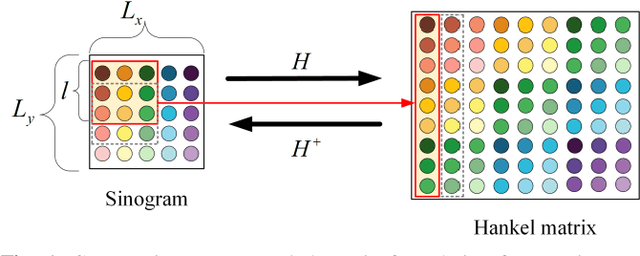
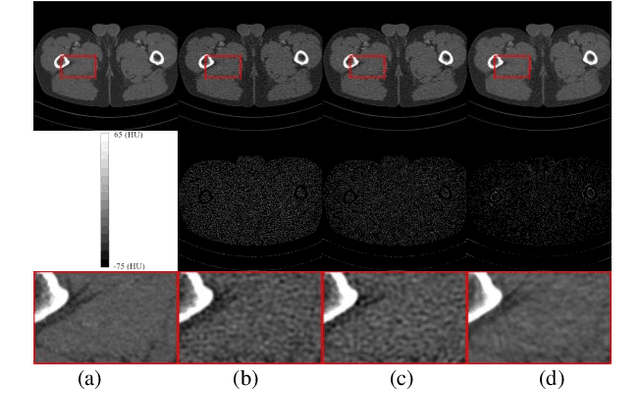
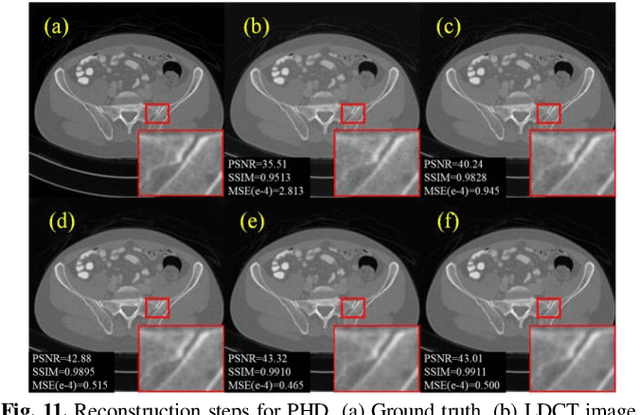
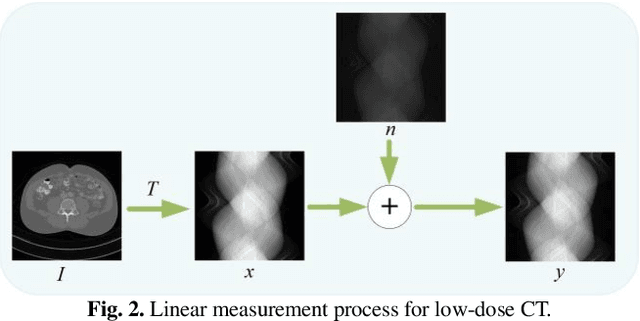
Abstract:Low-dose computed tomography (LDCT) plays a vital role in clinical applications by mitigating radiation risks. Nevertheless, reducing radiation doses significantly degrades image quality. Concurrently, common deep learning methods demand extensive data, posing concerns about privacy, cost, and time constraints. Consequently, we propose a few-shot low-dose CT reconstruction method using Partitioned Hankel-based Diffusion (PHD) models. During the prior learning stage, the projection data is first transformed into multiple partitioned Hankel matrices. Structured tensors are then extracted from these matrices to facilitate prior learning through multiple diffusion models. In the iterative reconstruction stage, an iterative stochastic differential equation solver is employed along with data consistency constraints to update the acquired projection data. Furthermore, penalized weighted least-squares and total variation techniques are introduced to enhance the resulting image quality. The results approximate those of normal-dose counterparts, validating PHD model as an effective and practical model for reducing artifacts and noise while preserving image quality.
MSDiff: Multi-Scale Diffusion Model for Ultra-Sparse View CT Reconstruction
May 09, 2024



Abstract:Computed Tomography (CT) technology reduces radiation haz-ards to the human body through sparse sampling, but fewer sampling angles pose challenges for image reconstruction. Score-based generative models are widely used in sparse-view CT re-construction, performance diminishes significantly with a sharp reduction in projection angles. Therefore, we propose an ultra-sparse view CT reconstruction method utilizing multi-scale dif-fusion models (MSDiff), designed to concentrate on the global distribution of information and facilitate the reconstruction of sparse views with local image characteristics. Specifically, the proposed model ingeniously integrates information from both comprehensive sampling and selectively sparse sampling tech-niques. Through precise adjustments in diffusion model, it is capable of extracting diverse noise distribution, furthering the understanding of the overall structure of images, and aiding the fully sampled model in recovering image information more effec-tively. By leveraging the inherent correlations within the projec-tion data, we have designed an equidistant mask, enabling the model to focus its attention more effectively. Experimental re-sults demonstrated that the multi-scale model approach signifi-cantly improved the quality of image reconstruction under ultra-sparse angles, with good generalization across various datasets.
GPT as Psychologist? Preliminary Evaluations for GPT-4V on Visual Affective Computing
Mar 09, 2024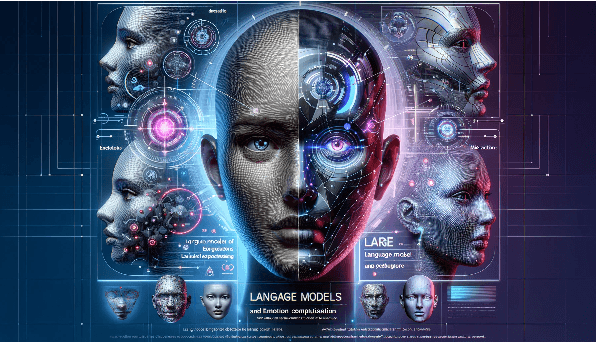

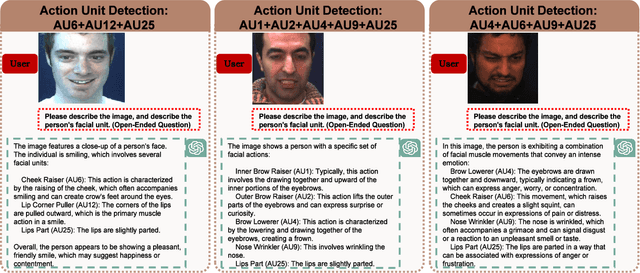
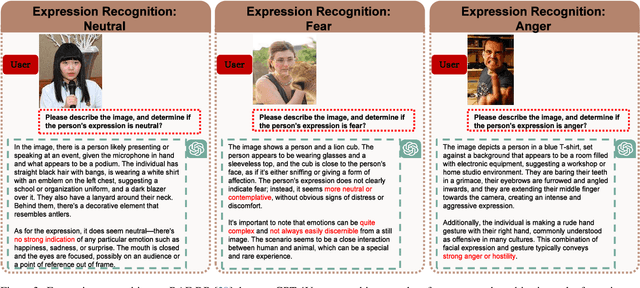
Abstract:Multimodal language models (MLMs) are designed to process and integrate information from multiple sources, such as text, speech, images, and videos. Despite its success in language understanding, it is critical to evaluate the performance of downstream tasks for better human-centric applications. This paper assesses the application of MLMs with 5 crucial abilities for affective computing, spanning from visual affective tasks and reasoning tasks. The results show that GPT4 has high accuracy in facial action unit recognition and micro-expression detection while its general facial expression recognition performance is not accurate. We also highlight the challenges of achieving fine-grained micro-expression recognition and the potential for further study and demonstrate the versatility and potential of GPT4 for handling advanced tasks in emotion recognition and related fields by integrating with task-related agents for more complex tasks, such as heart rate estimation through signal processing. In conclusion, this paper provides valuable insights into the potential applications and challenges of MLMs in human-centric computing. The interesting samples are available at \url{https://github.com/LuPaoPao/GPT4Affectivity}.
Financial Time-Series Forecasting: Towards Synergizing Performance And Interpretability Within a Hybrid Machine Learning Approach
Dec 31, 2023Abstract:In the realm of cryptocurrency, the prediction of Bitcoin prices has garnered substantial attention due to its potential impact on financial markets and investment strategies. This paper propose a comparative study on hybrid machine learning algorithms and leverage on enhancing model interpretability. Specifically, linear regression(OLS, LASSO), long-short term memory(LSTM), decision tree regressors are introduced. Through the grounded experiments, we observe linear regressor achieves the best performance among candidate models. For the interpretability, we carry out a systematic overview on the preprocessing techniques of time-series statistics, including decomposition, auto-correlational function, exponential triple forecasting, which aim to excavate latent relations and complex patterns appeared in the financial time-series forecasting. We believe this work may derive more attention and inspire more researches in the realm of time-series analysis and its realistic applications.
 Add to Chrome
Add to Chrome Add to Firefox
Add to Firefox Add to Edge
Add to Edge